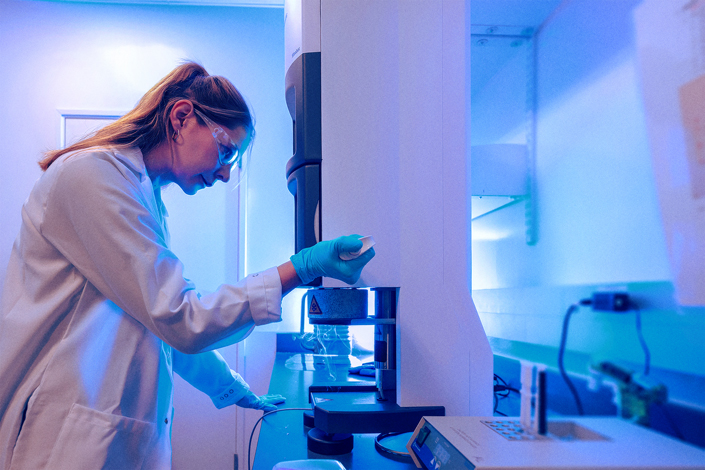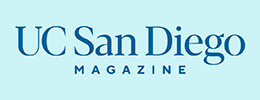The Goeddel Family Technology Sandbox is Open for Research
The state-of-the-art technology in the new UC San Diego facility will boost research, education and training.
Published Date
Story by:
Topics covered:
Share This:
Article Content
This story appears in the spring 2025 issue of UC San Diego Magazine as “Ready to Play.”
At the heart of many modern scientific discoveries lies technology — the tools that allow researchers to see, measure and understand life at its most fundamental levels. At UC San Diego, a state-of-the-art facility is redefining how scientists approach these breakthroughs.
The Goeddel Family Technology Sandbox, located in Bonner Hall — a building with a storied history of innovation — offers a cutting-edge collaborative space where disciplines intersect, ideas take shape, and the next generation of researchers gains hands-on experience with the latest tools and equipment that will drive the future of biology and medicine.
Named in recognition of a $7.5 million gift from biotechnology industry leader and UC San Diego alumnus David Goeddel ’72, the Technology Sandbox, developed in coordination with partners Thermo Fisher Scientific and Nikon Instruments, provides scientists with insights into living systems in action, from capturing the moment that a virus enters a cell to witnessing how a mutant protein might be triggering a disease.
“We have all this amazing technology under one roof that historically has been separated from each other,” says Uri Manor, assistant professor in the School of Biological Sciences and faculty director for the Technology Sandbox. “Typically, you’ll have chemists in one building with their equipment and biologists in another building with their equipment … The idea of a sandbox, aptly named, is to bring all these ‘toys’ together so these scientists can ‘play’ together.”
Two highly specialized features of the Technology Sandbox are cryo-electron microscopy (cryo-EM) and cryo-electron tomography (cryo-ET). In the past decade, these methods have become the world’s most powerful tools for analyzing the foundational properties of life with unprecedented precision. More advanced than traditional imaging methods, cryo-EM and cryo-ET samples are flash-cooled in a process that happens so fast that molecules are “frozen” in place to provide rich details of interactions and life functions.
The Technology Sandbox also features a suite for mass spectrometry, an analytical tool that reveals the chemical makeup of substances. Researchers are using mass spectrometry tools, along with other technologies, such as cryo-EM, to gain a better understanding of protein structures with increasingly vivid detail.

As part of its Nikon Imaging Center, the Technology Sandbox also hosts a world-class light microscopy suite, which allows scientists to visualize and study the fine details of samples. To create the necessary high-resolution images, researchers use microscopes that focus light through lenses (to illuminate and magnify specific properties of microscopic organisms) or electron microscopy (a method that uses beams of electrons to scan and highlight areas of interest).
With “toys” like these, the Technology Sandbox expects to attract experts to conduct research, facilitating interactions and interdisciplinary collaborations that could lead to novel discoveries.
“By democratizing access to transformative technologies, this facility will provide researchers with the resources and connections to bring innovative technology and medical treatments to the public realm, solving pressing national and global health problems,” says Corinne Peek-Asa, vice chancellor for Research and Innovation.
The Technology Sandbox also offers UC San Diego students unique opportunities to be trained on technologies universities typically don’t provide.
“The idea of a sandbox, aptly named, is to bring all these ‘toys’ together so these scientists can ‘play’ together.”
“The Goeddel Family Technology Sandbox has been instrumental to my graduate research. I wouldn’t have achieved the same success in my project without access to this facility,” says Sarah Narehood, MS ’23, a PhD candidate in the Department of Chemistry and Biochemistry. “The training here is truly unparalleled. Beyond providing advanced instrumentation, the facility’s personnel are incredibly supportive, always open to exploring new techniques.”
Narehood plans to pursue a career in structural biology, specifically cryo-EM, and says the connections she has made through the Technology Sandbox and the UC San Diego cryo-EM community will continue to shape her professional path.
“Bonner Hall is the perfect home for the Goeddel Family Technology Sandbox, as it has been the location of foundational discoveries in molecular and cellular biology since 1964,” says Kit Pogliano, dean of the School of Biological Sciences. “With the campus’s long history of innovation and continued support from federal and private sources, we will ensure that the Technology Sandbox can fulfill its mission and expand access to technologies and offer transformative opportunities for researchers and students to drive discovery for the next 60 years.”
You May Also Like
Stay in the Know
Keep up with all the latest from UC San Diego. Subscribe to the newsletter today.





